STEM Building in the Window Frame
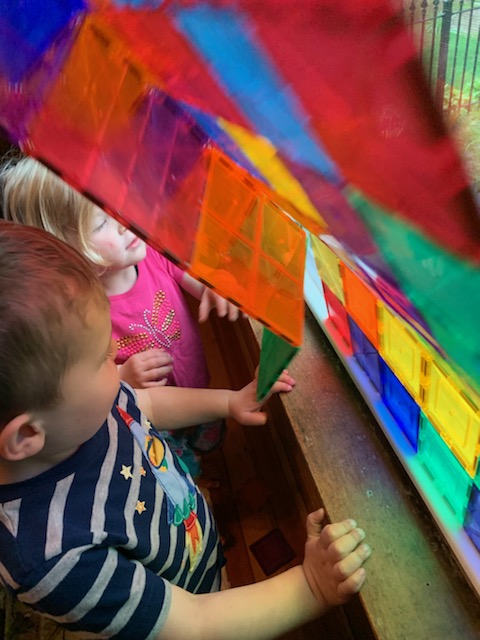
“AUGGGHHHH!” I hear screams, a crash and giggles galore.
The joy of Magna-Tiles® has returned to our ever-popular window-stacking play. When these colorful magnetic tile mosaics come crashing down from the window frame, the children respond with laughter and joy. By contrast, the collapse of three-dimensional block formations often elicits groans and tears.
Something about the suspense of the build (and the challenge of stacking the magnetic tiles higher and higher without triggering a collapse) keeps the children coming back to this activity time and time again.
For anyone unfamiliar with Magna-Tiles, they are magnetized tiles of different shapes that can be used to build the most amazing creations. We have purchased other magnetic block sets, but the children had difficulty figuring out the polarization or were frustrated by the lack of versatility. Ultimately, those more expensive sets were abandoned to collect dust in a corner while the children spent endless hours playing and learning with the Magna-Tiles.

Is there a more perfect block than a Magna-Tile? If I were stranded on an island with a group of preschoolers, this would be on my top-ten list of must-have learning tools. Heck, it would be on my top-three list. These are, without a doubt, the favorite block in our program. What’s not to love? Magna-Tiles build confidence and fuel hours of creative play. Our only problem with Magna-Tiles is that we never seem to have enough!
I read somewhere that you know you have enough blocks when there are still blocks on the shelves. I’m still not sure I have enough Magna-Tiles on any given day, and I always find myself purchasing more. (Full disclosure: I often purchase PicassoTiles, which are less expensive, equally rugged and nearly identical to my original Magna-Tile set. So, if your program is on a budget, don’t hesitate to buy this less expensive set.)
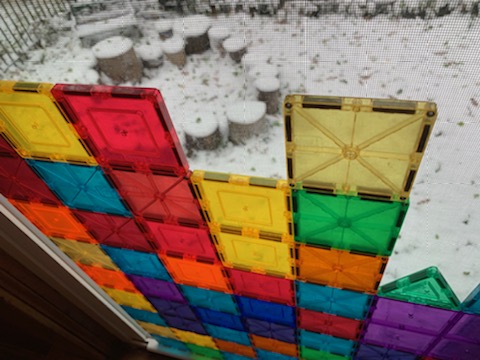
Magnetic tiles are a STEM classroom delight. We have math opportunities with shapes and colors, counting, blending colors, angles and geometry galore! We have science and engineering as we explore different designs and building techniques. The magnetic feature opens doors to design and construction options that regular wooden blocks cannot provide.
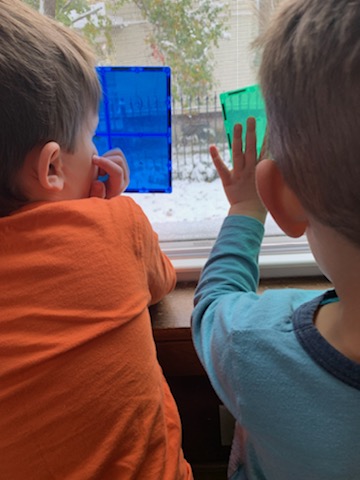
“What color is your tree?” Harrison asks his best friend, Jack, as they use their magnetic tiles to change the colors of the scene outside our window.
The collaboration continues as the two boys follow their creative impulses and develop their ideas.
Then Jack proposes a new challenge. “What if we try a triangle this time?”
The boys determine that the results will be the same regardless of the shape. I am convinced that the children’s understanding of different shapes has been greatly enhanced by the use of these magnetic tiles. Magnetic tiles are the perfect educational tool for teaching all things geometric!
I also love to observe the children as they engage in problem-solving when they are confronted with a shortage of large square magnetic tiles. They quickly determine that they can create the same shape with four smaller magnetic tile squares.
Magnetic tiles also lay the foundation for an understanding of sets and quantities, as well as concepts such as location and ordinal positioning as the children expand their STEM knowledge and vocabulary.
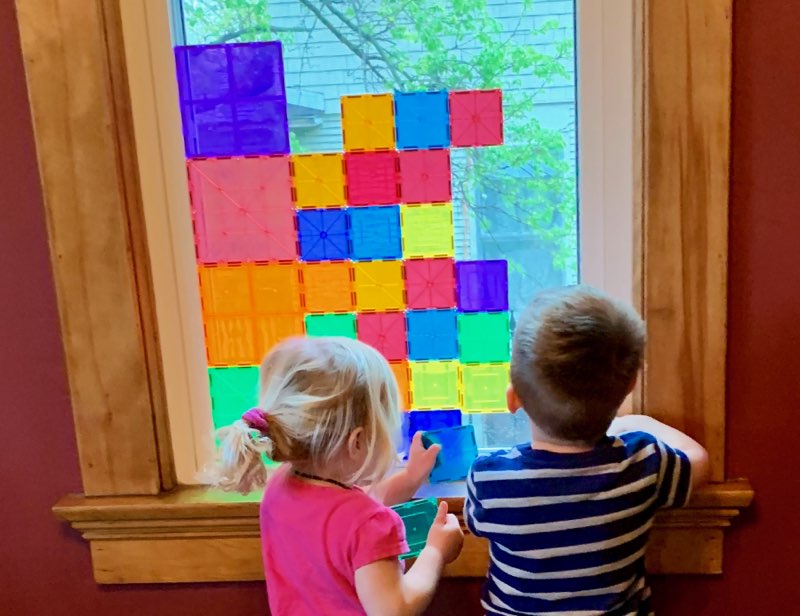
“Jack, do you think we can add this square and it won’t fall down?” asks Jack’s twin sister, Eve, who is working through her predictions and collecting data on what works and what doesn’t.
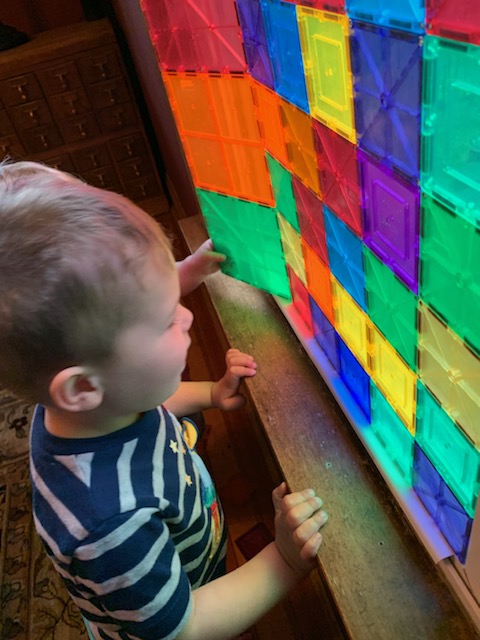
I watch as Eve gingerly pries the corner of the bottom tile away from the window and triggers a structural collapse that brings all of the magnetic tiles tumbling down.
This investigation of “What happens if…?” is met with delight and infectious laughter from Eve’s peers as the building collaboration starts all over again.
“If we add this triangle to the top, the trees will turn green and look different from the red trees down here.”
Jack and Eve continue to pursue different avenues of learning with the tiles. One minute they are investigating colors and the next they are observing patterns or determining which shape should be added to the mosaic.
 I’ve noticed yet another benefit of our window-frame magnetic-tile mosaics: The activity often brings children together who don’t naturally play side-by-side.
I’ve noticed yet another benefit of our window-frame magnetic-tile mosaics: The activity often brings children together who don’t naturally play side-by-side.
In other words, this group endeavor builds community. I am not sure if it’s a team effort of US versus the WINDOW BLOCKS or if it’s simply the contagious joy of the activity that makes everyone want to join in the fun.
When the temperatures drop below zero for days on end, I know that I can count on our magnetic tiles to lighten the mood and enrich our learning through play.
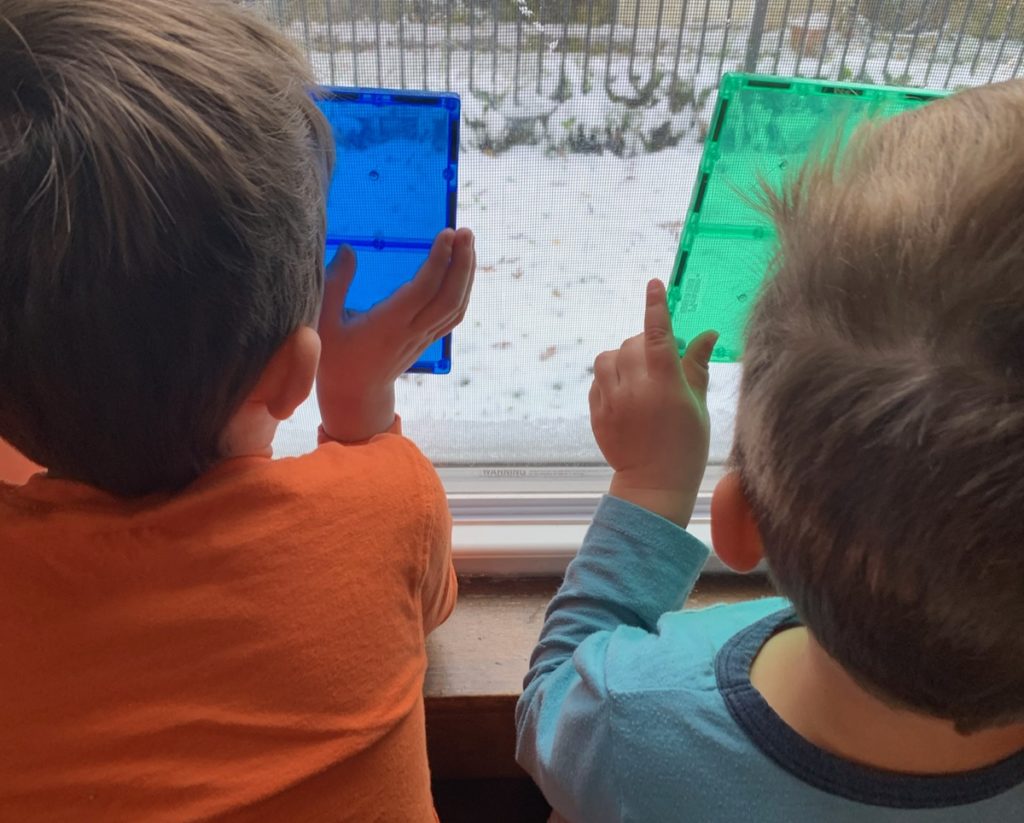
One more note: I have been known to remove the magnetic tiles from our play on occasion.
Why? Because I believe that magnetic tiles are so easy to use that they create “lazy builders.” This is just a personal theory of mine, but I’ve seen it play out over and over again. Sometimes the children in my program need to be pushed out of their comfort zone.
I do this by pulling out my wooden unit blocks, which require the children to perfect the balance and symmetry skills needed to build a stable block tower.
When those wood towers fall, I remind my wee ones that they are great builders and then I help them start building again from the foundation up.
When I rotate the magnetic tiles back into our play after a period of going “back to basics” with the wooden blocks, I nearly always notice that the children’s building skills have improved.
Try it and let me know your results. Happy building!

Yes it is much more fun building with the magnetic blocks but you are correct that when taken away and replaced with wooden blocks, their skills in building have sharpened some. I guess I never really noticed that before but thanks for the observation and input. Greatly appreciated.
Our children love these never thought of using them in the window a great creative idea. I do agree on putting them away due to children getting lazy on building our children would just use those and forget regular blocks